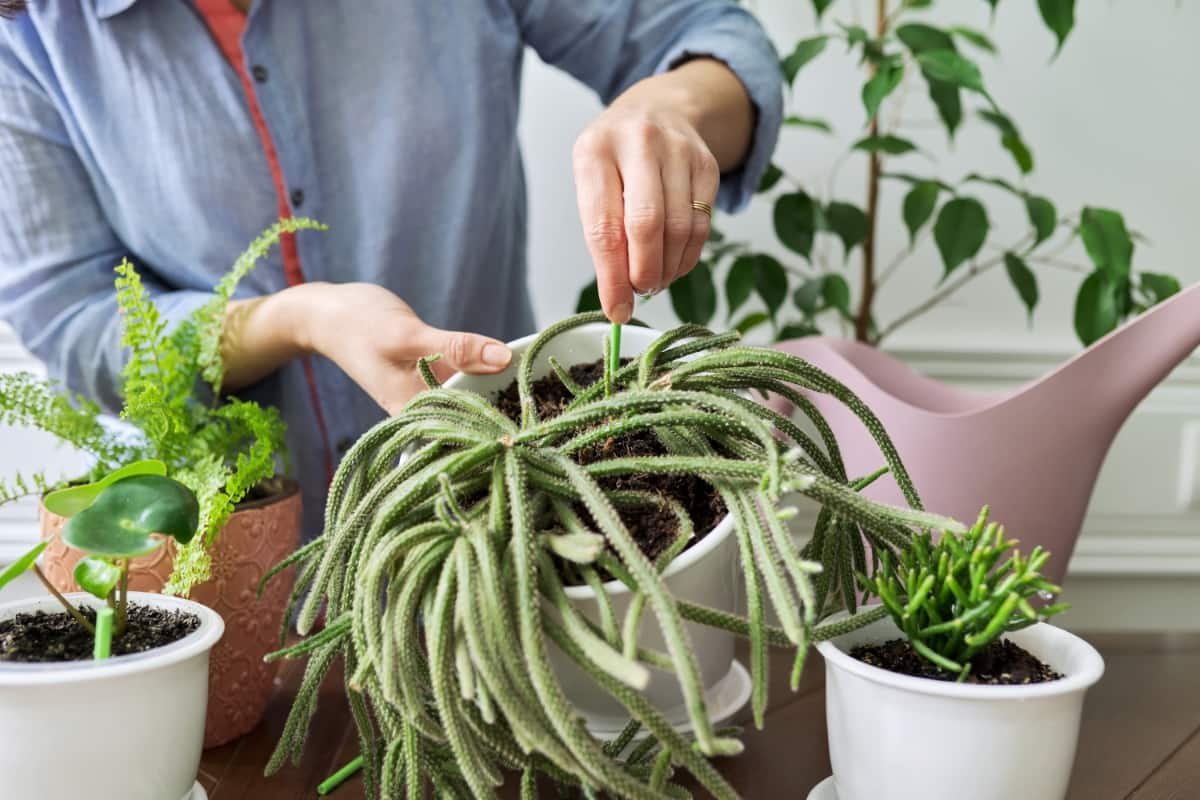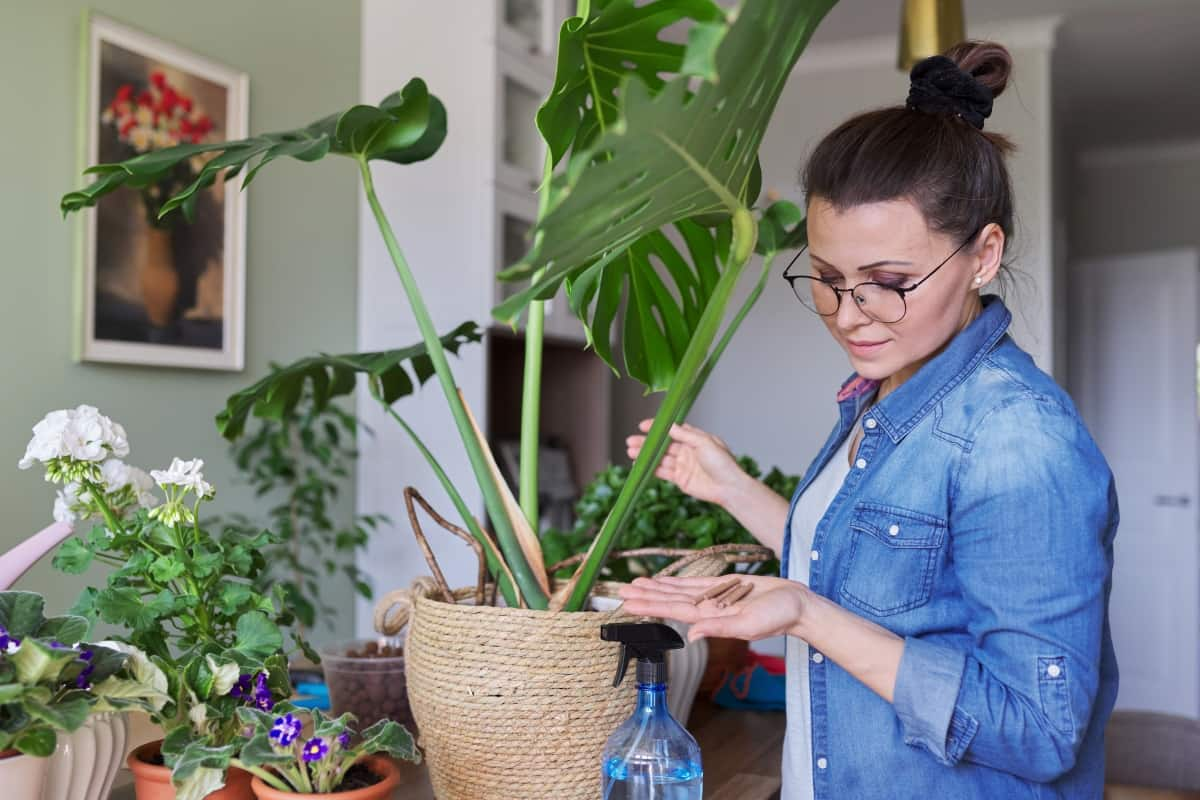Applying NPK fertilizer to potted plants is crucial for their health and growth. NPK fertilizer stands for nitrogen (N), phosphorus (P), and potassium (K) – three key elements that plants need in varying amounts. Each element is crucial in plant health, from boosting leaf development to promoting root growth and enhancing flowering. But why is fertilizing houseplants with NPK so important?

Just as humans need a balanced diet for optimal health, plants also require a well-rounded nutrient profile. While soil provides some nutrients, it may not always be enough or lack certain elements. Is NPK good for all plants? Nitrogen helps with leafy growth and overall plant vigor, while potassium aids root development and promotes healthy flowering. On the other hand, phosphorus plays a crucial role in flower formation and enhancing fruit production.
How to Apply NPK Fertilizer to Potted Plants
NPK Benefits for Plants
| Types Of Fertilizers For Plants | Benefits |
| Nitrogen | For plant color and growth |
| Phosphorous | For fruit and flowers |
| Potassium | For strong roots |
Step-By-Step Guide: Applying NPK Fertilizer to Potted Plants
Prepare the potting soil – Before applying NPK fertilizer to your plants, ensure the soil is well-drained and moist.
Choose the right fertilizer – Look for a balanced NPK fertilizer with the appropriate ratio for your specific type of plant. Remember, different plants have different nutrient requirements, so choosing accordingly is important.
Measure and mix – After choosing your fertilizer, carefully measure the recommended amount based on your pot size and plant needs. Mix it into a small bucket or container with water until fully dissolved.
Apply evenly around the base of your plants – Using a watering can or sprayer, apply the diluted fertilizer solution evenly around the base of each potted plant. Be careful not to oversaturate or splash too much onto leaves, which may cause damage.
Water thoroughly after application – After applying NPK fertilizer, give your plants good watering to help distribute nutrients throughout their root systems and prevent any potential burning from concentrated solutions.
Best Practices for Applying NPK Fertilizer to Potted Plants
Firstly, always read the instructions on the fertilizer packaging carefully. Each brand and type of fertilizer may have specific guidelines for application. Before applying the fertilizer, make sure your potted plant is well-watered. This will prevent any potential burn from the concentrated nutrients in the fertilizer.
In case you missed it: Best Fertilizer for Hyssop Plants in Pot: Organic, Natural, Homemade, NPK Ratio, When and How to Apply

Choosing the right fertilizer dosage for your plant size and type is also important. Too much or too little fertilizer can be detrimental to its health. When applying the NPK fertilizer, aim for even distribution throughout the potting soil.
The Importance of Properly Applying NPK Fertilizer to Potted Plants
One key importance of applying NPK fertilizer correctly is that it provides nutrients that may be lacking in the plant’s soil. Nitrogen, phosphorus, and potassium play vital roles in plant development, from root growth to flower production.
By following best practices for applying NPK fertilizer, such as diluting it properly and distributing it evenly within the container, you maximize its benefits while minimizing potential risks. Remember always to read the instructions on your chosen fertilizer product and adjust accordingly based on the specific needs of each type of potted plant you own.
Dos and Don’ts of NPK Fertilizer Application in Potted Plant Care
Firstly, read the fertilizer package instructions carefully before applying it. Different fertilizers may have different application rates, so following the recommended dosage is crucial. Make sure that your plants need fertilization before applying NPK fertilizer. Over-fertilizing applications can lead to nutrient imbalances and even burn the roots of your plants. It’s always best to test the soil first or consult a gardening expert if unsure.
Don’t apply NPK fertilizer directly onto dry soil or foliage. Water your plants thoroughly before fertilizing, as this helps prevent root damage and ensures proper absorption of nutrients. Additionally, avoid getting fertilizer on leaves as it could cause leaf burn. Do consider using slow-release fertilizers for potted plants. These fertilizers release nutrients gradually, providing a steady supply for your plants’ needs without risking overfeeding them.
Don’t neglect regular watering when using NPK fertilizer. While it provides essential nutrients for growth, water is equally necessary for nutrient uptake by plant roots. Do monitor your plants closely after applying NPK fertilizer. Look for signs of stress or nutrient deficiencies, such as yellowing leaves or stunted growth.
How to Determine the Right Amount of NPK Fertilizer for Potted Plants?
It’s important to understand the specific needs of your plants. Please read up on their preferred N-P-K ratios and adjust accordingly. Next, consider the size of your plant and its container. Larger pots may require more fertilizer than smaller ones since they hold more soil volume. Another factor to consider is the growth stage of your plant.
During active growing seasons, such as spring and summer, they need more nutrients than dormant periods like winter. Which NPK fertilizer is good for plants? A balanced NPK ratio of 4-1-3 or 6-1-4 is ideal for most indoor plants. These NPK nutrients are essential for plant growth and development.
Timing Matters: When to Apply NPK Fertilizer to Potted Plants
Proper timing is crucial when applying NPK fertilizer to potted plants. Early spring through late summer is considered the ideal time for fertilization, as most plants are in their active growth phase. Early spring to late summer is the best time to use NPK to fertilize houseplants sparingly.
In case you missed it: Best Plumeria Fertilizer: Organic, NPK, Slow-Release, and Water-Soluble

Techniques for Evenly Distributing NPK Fertilizer in Potted Plant Containers
- Mixing the fertilizer: Thoroughly mix it with soil or potting mix before applying the fertilizer. This helps in dispersing the nutrients more evenly throughout the container.
- Layering technique: Start by adding a layer of soil at the bottom of the container, then sprinkle a thin layer of fertilizer on top. Repeat this process until you reach the top of the container, covering all areas.
- Watering technique: After applying fertilizer, water your potted plants thoroughly. This helps distribute nutrients evenly and prevents any potential burning caused by concentrated fertilizers.
- Stirring technique: For larger pots or containers, use a small gardening tool like a trowel to gently stir and mix the soil and fertilizer periodically throughout the growing season.
Adjusting NPK Ratios for Different Types of Potted Plants
Each type of plant has different nutrient requirements, and it’s important to adjust the NPK ratios accordingly. For example, leafy green plants like lettuce and spinach thrive with higher nitrogen levels (N), promoting healthy foliage growth. A ratio of 3-1-2 or 4-1-2 is recommended for these types of plants.
On the other hand, flowering plants such as roses and geraniums benefit from higher phosphorus (P) levels, which encourages blooming. A ratio of 1-3-2 or 1-2-2 works well for them. Fruit-bearing plants like tomatoes and peppers need a balanced ratio with more potassium (K). This nutrient helps with fruit development and overall plant health. An ideal ratio could be 3-1-5 or even 4–6–8.
Troubleshooting Common Issues in NPK Fertilizer Application for Potted Plants
Burned or Browning Leaves: It could be over-fertilization if your potted plants’ leaves turn brown or show signs of burn. This occurs when too much NPK fertilizer is applied or if it is not properly diluted. To fix this issue, thoroughly flush the soil with water to remove excess salts and allow the plant to recover.
Lack of Growth or Yellowing Leaves: On the other hand, if your potted plants are experiencing slow growth or yellowing leaves, it could indicate a nutrient deficiency. Consider adjusting the NPK ratio using a different fertilizer formulation that suits your plant’s needs better.
Nutrient Imbalance: Applying too much of one nutrient while neglecting others can result in an imbalance that affects plant health and development. Regularly check your potted plants for any signs of deficiencies (such as stunted growth or discoloration) and adjust your fertilizer application accordingly.
NPK Deficiency Symptoms in Potted Plants
| Element | Deficiency symptoms |
| Nitrogen (N) | Chlorosis generally occurs, especially in older leaves; in severe cases, the plant leaves turn yellow and die. Some plants exhibit purple coloring due to purple pigment accumulation |
| Phosphorus (P) | A dark green plant that becomes red or purple as it accumulates anthocyanins; in later stages of growth, the stems become stunted, and older leaves turn brown and die |
| Potassium (K) | There are spots of dead tissue on the tips and margins of leaf tips or stems; mostly older leaves are affected. |
In case you missed it: Best Fertilizers for Bamboo: Organic, Synthetic, Slow-release, NPK, and Liquid Fertilizers

Conclusion
Proper distribution of NPK fertilizer within your potted plant container ensures even nutrient uptake by all parts of your plant’s root system. Timing is important when applying NPK fertilizer. Generally, early spring through late summer is the best time to fertilize houseplants sparingly. During this active growth period, they can absorb and utilize the nutrients provided by the fertilizer.
- Feed Your Flock for Less: Top 10 Tips to Save on Chicken Feed
- Ultimate Guide to Ossabaw Island Hog: Breeding, Raising, Diet, and Care
- Hatching Answers: The Top 10 Reasons Your Chickens Aren’t Laying Eggs
- Eggs and Economics: Breaking Down the Cost of Raising Backyard Chickens
- Defend Your Greens: Proven Methods to Keep Iguanas Out of Your Garden
- Ultimate Guide to Cinnamon Queen Chicken: A Comprehensive Guide for Beginners
- Ultimate Guide to California Tan Chicken: Breeding, Raising, Diet, Egg-Production and Care
- Ultimate Guide to Marsh Daisy Chicken: Breeding, Raising, Diet, and Care
- 10 Types of Chicken Farming Businesses You Can Start for Profits